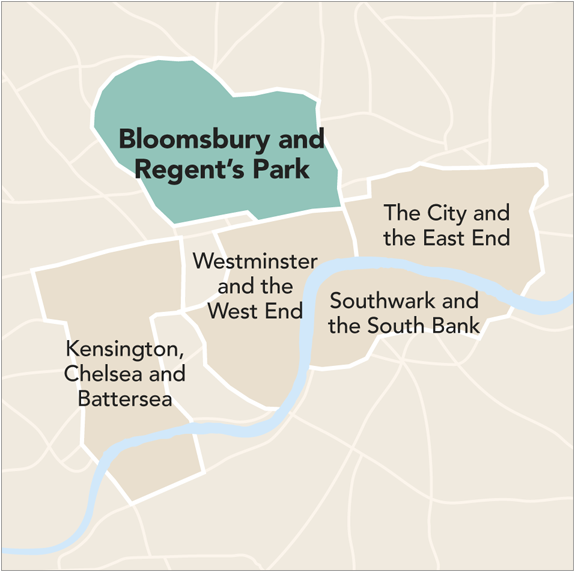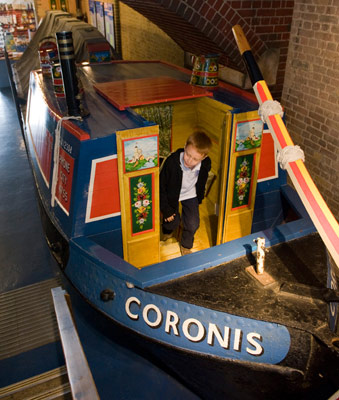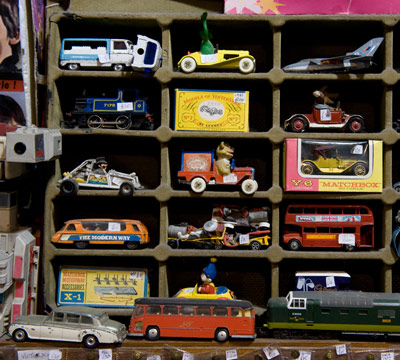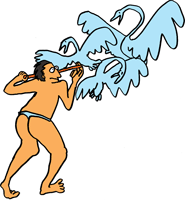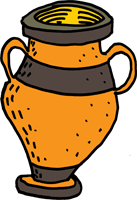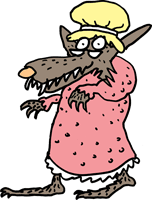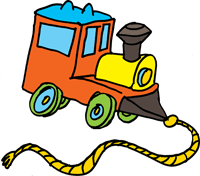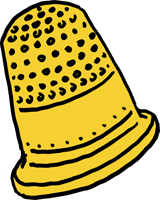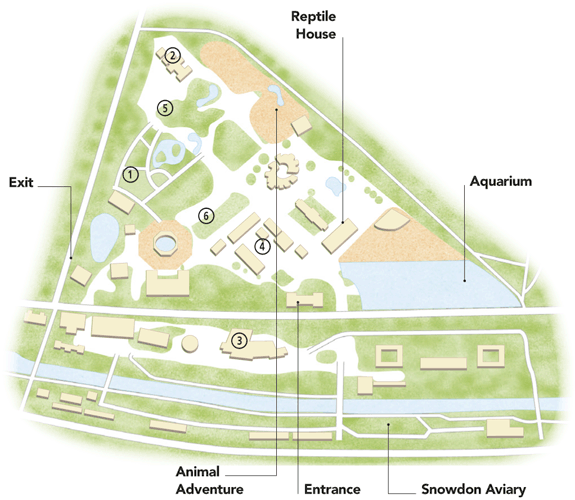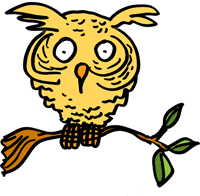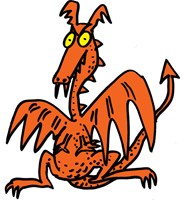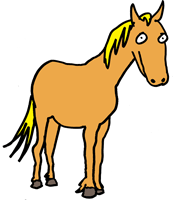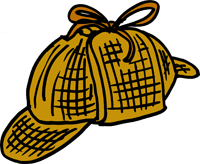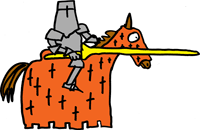< Bloomsbury and Regent’s Park
British Museum and Around
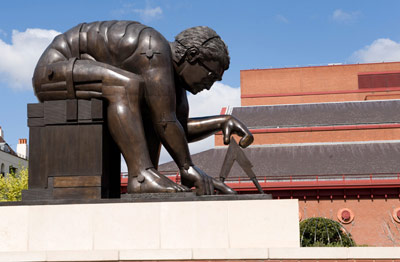
Bronze statue of Sir Isaac Newton outside the British Library
With Sir Norman Foster’s splendid Great Court, a cavernous igloo of white space, the British Museum has one of the grandest entrance lobbies in the world. All-action art workshops take place here every weekend, there is a dedicated children’s shop and two cafés. The museum is free to visit and picnicking is permitted: throw in the marvellous playground at nearby Coram’s Fields, and this must be London’s best budget day out for families. Bloomsbury has a clutch of smaller museums too, devoted to toys, cartoons, canal boats and more.
1. British Museum
2. Pollock’s Toy Museum
3. Wellcome Collection
4. British Library
5. Foundling Museum
6. Charles Dickens Museum
7. London Canal Museum
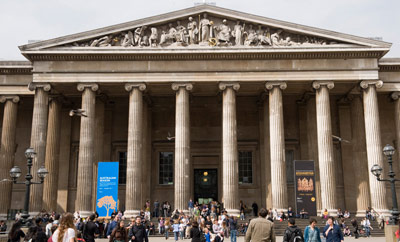
The British Museum, packed with interesting and exotic exhibits from around the world
1. British Museum
Heaps of human history under one roof
Pirate gold, a crystal skull, fanged demons – the British Museum is jammed full of wonders. Three floors of galleries chart two million years of human civilization across the globe, so it pays to be choosy. The Egyptian Collection (Rooms 61–66) and Living and Dying (Room 24) are impressive, with their mummies and skulls. Start in the Families Centre in the Great Court, for free kids’ trails and backpacks.
Key Features
1. Great Court Once an outside courtyard, this is now the largest covered public space in Europe.
2. Rosetta Stone Carved with a pharaoh’s decree from 196 BC, this is the museum’s most visited treasure. It is written in three languages, which enabled experts to decode Egyptian hieroglyphs for the first time. (Room 4)
3. Abydos cat mummy The ancient Egyptians worshipped cats, mummifying thousands as offerings to the cat-goddess Bastet. (Room 62)
4. Pirate treasure Long John Silver’s parrot squawked “pieces of eight” – and here they are. In Tudor times (c.1500–1600), these Spanish coins were worth about £50. (Room 68)
5. The Royal Game of Ur This Ludo-like dice game was played 4,500 years ago in Mesopotamia. Players raced across the board, trying to land on the lucky rosettes. (Room 56)
6. Ball game belt This toad-shaped belt featured in the world’s oldest team sport, a type of volleyball played in ancient Mexico. Defeat could be dangerous – the losers were sacrificed to the gods! (Room 27)
7. Camera coffin The Ga people of Ghana have been fashioning these fantastical coffins since the 1950s to represent the dead person’s interests – such as photography, eagles or planes. (Room 24)
8. Mold Cape Discovered in a Welsh burial mound, this Bronze Age cape was a pile of gold fragments, leaving curators with a giant jigsaw puzzle to tackle. (Room 51)

Left
Pirate treasure Middle Great court Right Rosetta stone
Kids’ Corner
Conquering hero
The ancient Greek hero Herakles had to complete 12 dangerous “labours”, slaying monsters and killing wild beasts. He pops up all over the museum. See if you can find him…
- Killing the man-eating Stymphalian birds (Room 69)
- Finding the magic apples of the Hesperides (Room 19)
- Fighting Hippolyta, Queen of the Amazons (Room 16)
Treasure chess?
With their comical faces, the Lewis chessmen (Room 40) are very mysterious. Probably from Norway and carved from walrus tusks, they were buried in sand in Scotland more than 800 years ago – but no one knows why.
Name game
The British Museum sometimes uses unusual words for simple things. Can you work out what the following objects are? The room numbers should help you…
-
An amphora (Room 69)
-
A ewer (Room 40)
-
A relief (Room 10)
2. Pollock’s Toy Museum
Playtimes from the past
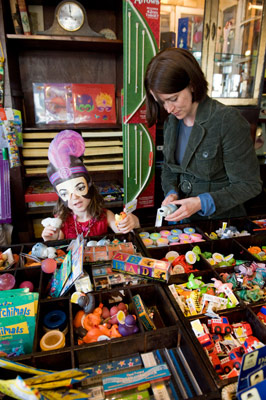
Browsing among the exciting toys in the toyshop of Pollock’s Toy Museum
Winding your way around the snaking stairways and attic rooms of this rickety old house feels like going back in time – which is appropriate, since they are filled with a treasure trove of toys spanning two centuries. Don’t tell the children, but it’s an irresistible nostalgia trip for parents, too.
The charming, idiosyncratic collection includes Schoenhut’s Humpty Dumpty Circus from 1903, and a reconstructed early 20th-century boy’s den, complete with dangerous-looking chemistry set and blow football. One room is devoted to the delicate but magical paper theatres of the Pollock family, whose renowned Victorian toy emporium spawned the museum in 1956. Other rooms concentrate on early teddy bears, toy soldiers and slightly spooky wax dolls.
The labels are yellowing and there’s little to touch or play with, so give thanks for the toyshop at the end of the visit, stacked with superannuated treats – spinning tops, kaleidoscopes and classic card games such as Happy Families. Pollock’s Toy Shop in
Covent Garden also sells great toys.
Kids’ Corner
Snakes and ladders
With its twisty staircases, Pollock’s Toy Museum feels like a real-life game of snakes and ladders. So let’s play! Try to spot the toys listed below – when you do, move on to the next room. First to reach the shop wins!
-
Room 1 A wolf dressed as grandma
-
Room 2 A crocodile eating some sausages
-
Room 3 A clay mouse
-
Room 4 A teddy with one ear
-
Room 5 A doll with a skipping rope
Toot toot!
The first children’s train sets used a real hot-water boiler to drive the engine along. They were quite dangerous – they dribbled fuel on the carpet, caused fires and sometimes even exploded!
3. Wellcome Collection
Shrunken heads and massive moustaches
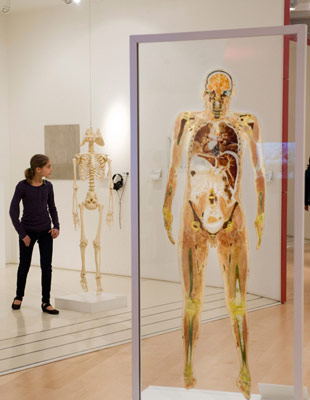
Examining the curious medical exhibits in the Wellcome Collection
On a par with Ripley’s Believe It Or Not (see
Piccadilly Circus) is the Wellcome Collection. This giant store of curiosities was collected by an eccentric adventurer called Henry Wellcome, who made his fortune as a medicine salesman, grew Victorian England’s bushiest moustache, then travelled the world hunting for medical marvels. He returned with some very bizarre booty indeed: prepare to be amazed by a torturer’s mask, a Peruvian mummy (minus bandages) and a peculiar device for blowing tobacco smoke up a drowning person’s bottom.
The historical gallery is beautifully arranged: slide open drawers to hear sound clips about key objects or to reveal artifacts to touch. The curators are oddly ambivalent about younger visitors: they stress that some of the material has adult themes, yet the museum has produced one of the best children’s explorer kits in London, with modelling clay, a false moustache and a guide to making a shrunken head. Parental discretion is needed – steer sensitive souls away from the birth and death cabinets, and focus instead on the exotic masks, votive amulets and celebrity ephemera (Napoleon’s toothbrush, George III’s hair).
The Wellcome’s second gallery, Medicine Now, feels very different: starkly lit and stylish, and devoted to modern wonders such as Dolly the cloned sheep and the human genome. Downstairs in the lobby there are temporary exhibitions on health and well-being, plus a cool café with free Wi-Fi and screens for browsing the museum’s collection.
Kids’ Corner
Hair today…
At the Wellcome Collection, hunt for locks of hair that belonged to two famous rulers. Scientists have found the same nasty stuff in both tufts, and for both men it may have led to their downfall. Who were the men, and what was the poison?
4. British Library
Sshhh! – a temple for books and the printed word
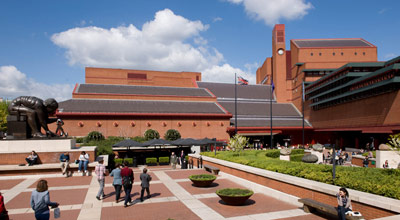
The spacious courtyard of the British Library
Fourteen million books, three million sound recordings, almost a million journals and newspapers… and just one permanent public gallery. For such a vast institution, the British Library offers thin pickings for the general visitor, especially for families – guided tours are pitched at adults and under-18s are barred from accessing the sound archives.
However, the Treasures Gallery offers a changing collection of important tomes, from England’s first printed book, the Gutenberg Bible (c.1455), to Leonardo’s Da Vinci’s notebooks, a draft score of Handel’s Messiah, and Captain Scott’s South Pole diaries. For children, the displays are saved from dryness by sound stations where they can listen to bursts of Brahms or the Beatles, and especially by the Turning the Pages interactive displays with touch-screen browsing. Flick through Lewis Carroll’s original Alice’s Adventures Under Ground, with the author’s own pictures; or novelist Jane Austen’s History of England, written when she was 15 – she had very neat handwriting, too.
5. Foundling Museum
A poignant tale of children lost and found
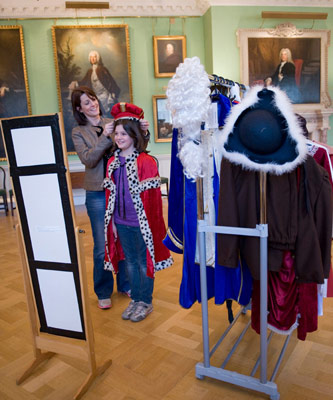
Dressing up in a rich child’s costume at the Foundling Museum
No single room in any London museum tells a more moving story than the main gallery here. In the early 18th century, before orphan-ages were established, a thousand babies were abandoned in London’s back streets each year – most of them reluctantly – by their destitute mothers. Pioneering shipwright Thomas Coram (1668–1751) led a heroic 20-year campaign to launch a Foundling Hospital to take them in.
The story has all the ingredients of a blockbuster, from the hospital’s celebrity patrons (George Frideric Handel performed his Messiah to raise funds; William Hogarth donated paintings, which still hang upstairs) to anguished mothers drawing lots to discover whether their tiny bundles would be saved by the orphanage. Today, visitors get to experience the lottery too – if they draw out a black ball, their “baby” is rejected. There are recordings of interviews with former foundlings (the hospital finally closed in 1953), and most heartrending of all, a collection of tokens left behind by mothers who hoped one day to reclaim their child.
Themed activity packs help to focus young minds on the story, while in the immaculate Georgian picture gallery, kids can dress up, or browse in the reading corner – which includes Hetty Feather, a tale about a Victorian inmate by Jacqueline Wilson. Better still, the guide is a perfect way to whet the appetite before a visit.
Kids’ Corner
Tiny tokens
At the Foundling Museum, find the tokens left behind by mums so they could identify their children if they returned. Which of these objects is NOT in the case: thimble, hairpin, fish, nut, pencil sharpener, coin. What would you leave behind? Why not draw a picture of it?
Yum yum!
How would you like to eat these dishes from the Foundling Hospital’s Victorian menu?
- Gruel: thin porridge made with barley and water
- Pease pottage: mashed-up peas mixed with spices
- Flummery: bland blancmange made with stewed fruit
The famous foundling
Imagine living at the Foundling Hospital for your whole life. John Brownlow was abandoned there as a baby and later took charge of the hospital, running it until he was 72. John was so kind to children that Charles Dickens borrowed his name for Mr Brownlow, the caring gentleman in his story Oliver Twist.
6. Charles Dickens Museum
Oliver Twist’s birthplace
The creator of Oliver, Tiny Tim and Little Nell loved children – he had 10 of his own after all. A leading proponent of child welfare in poverty-stricken Victorian London, Dickens lived at this smart Holborn townhouse from 1837–9, and wrote Oliver Twist and Nicholas Nickleby here.
The building has been preserved as Dickens knew it, and original furniture, manuscripts and interesting memorabilia such as the quills he used are on display. There are Victorian cookery demonstrations and the house is animated by sound clips of Dickens’ words. After a major refurbishment, the museum is more child-friendly, with regular family activities and a kids’ trail.
7. London Canal Museum
Horse dung and ice cream
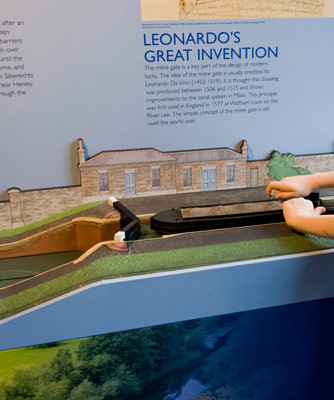
Interactive display showing how a lock’s mitre gate works
Britain’s canal age endured for longer than one might imagine – barges carrying cargo were still moving through Battlebridge Basin on the Regent’s Canal in the 1960s. That’s good news for the museum that now sits here, because lots of fascinating oral history survives – pick up the antique-style telephones and listen to William Tarbit describe what it was like to live and work on the canals: how he had to crawl into his narrowboat’s coal box to clean it – aged three! – and how he snared rabbits and pheasants for his mother’s poacher’s pie.
The museum has a traditional feel, with an authentic 1850s warehouse setting. It is half filled by the vintage barge Coronis, on which younger children can play. The cramped cabin might once have accommodated a family of six. Step out onto the wharf for a look at some modern narrowboats, and visit the re-created blacksmith’s workshop and stable upstairs.
The museum’s other theme is guaranteed to get kids’ tastebuds tingling: the Victorian ice cream trade. The underground chasm in the downstairs gallery once stored vast blocks of ice, imported on barges from Norway by the pioneering pudding-maker Carlo Gatti in the days before refrigeration. And never fear – there is ice cream for sale at the museum shop.
Kids’ Corner
Treat time
At the Canal Museum, see if you can find the names of these two ice-cream treats enjoyed by Victorian children…
-
A soft scoop served in a little glass
-
A slice of ice cream wrapped in paper
Get them right and you might be able to have an ice cream!
< Bloomsbury and Regent’s Park
ZSL London Zoo and Around
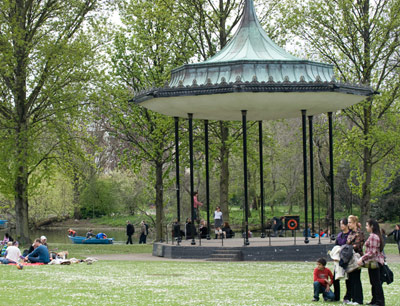
Elegant bandstand in Regent’s Park
There are gorillas and tigers to see of course, but these days London Zoo gives centre stage to its smaller creatures, devoting walk-through enclosures to monkeys and meerkats, penguins and sloths. Wait for some sunshine, and dedicate a full day to get the best value for the entrance fee. The nearest Tube station is Camden Town, but it gets congested on Sundays, when the area’s manic markets are in full swing. Consider travelling to Baker Street or Regent’s Park station, and walking across Regent’s Park, with a game of hide-and-seek along the way. Another great option is a canal tour from Camden Lock.
1. ZSL London Zoo
2. Regent’s Park
3. Camden Market
4. Jewish Museum
5. Madame Tussauds
6. Sherlock Holmes Museum
7. The Wallace Collection
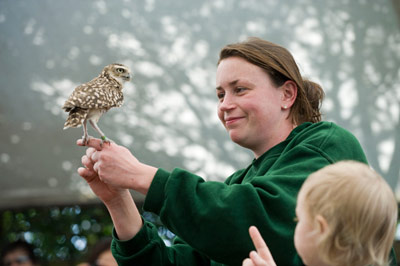
An “Animals in Action” demonstration at ZSL London Zoo
1. ZSL London Zoo
Face to fang with the world’s wildlife
An architectural oddity, ZSL London Zoo is full of strange 1930s buildings, but it also has a gorilla compound, an interactive children’s zoo, a tiger territory and a “penguin beach”. Kids will be kept busy tiptoeing along the balancing bars in the monkey enclosure, crawling into an aardvark’s burrow, or smiling at sloths in the walk-through rainforest. The zoo’s watchword is “immersive”, and it brings visitors closer to the animals than ever before.
Key Features
1. Butterfly Paradise A walk through butterfly house set in a giant inflatable caterpillar. The fluttering insects sometimes mistake brightly dressed visitors for flowers, so watch out for hitchhikers!
2. Blackburn Pavilion Home to jewel-coloured hummingbirds and splendid sunbirds, this steamy tropical bird-house is themed on Victorian explorers. Get ready to take flight!
3. Rainforest Life This hothouse takes visitors right in among snoozing sloths and scurrying tamarin monkeys, which chase along the creepers overhead.
4. Gorilla Kingdom This luxury island enclosure is home to a troop of western lowland gorillas. Watch these impressive apes show off their skills on a climbing wall and swing ropes.
5. B.U.G.S! There are handling sessions here and views of bird-eating spiders, naked mole rats and the zoo’s bug experts in their laboratory.
6. Animals in Action The zoo’s captivating live show runs daily in the amphitheatre. Kids watch wide-eyed as George the Macaw and Archie the Owl swoop on the stage.

Left
Tamarin monkey in the Rainforest Life exhibit Middle Praying mantas Right Captivating live show
Kids’ Corner
Super-beasts!
Which of these amazing animal facts do you think are true? The answers can all be found somewhere in the zoo.
-
Butterflies can taste with their feet. As well as nectar, they like to eat rotten fruit, manure and even blood!
-
Ring-tailed coatis can bend their ankles both ways, which comes in handy when running up and down trees!
-
A lion can eat 18 kg (40 pounds) of meat in one sitting – that’s nearly 160 burgers! Which of those superpowers would you like to have?
Group identity
Everyone has heard of a pack of wolves and a herd of deer, but which groups of animals do these words describe?
-
A prickle of …?
-
A flamboyance of …?
-
A tower of…?
-
An ambush of …?
-
A romp of …?
They are all found at London Zoo.
Spot the ape
London Zoo’s gorillas all enjoy doing different things…
* Effie is very loud and loves nothing more than coconut treats
* Zaire, the zoo’s oldest gorilla, enjoys uprooting and replanting flowers when it’s sunny
* Mjukuu, the youngest gorilla at the zoo, relishes ice-lollies made from frozen fruit tea
2. Regent’s Park
Playgrounds and playhouses
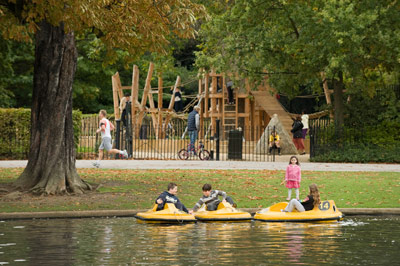
Messing about on the water, always a fun option for children in Regent’s Park
On a sunny day, few stretches of ground in London lift the spirits quite like Regent’s Park. There is just so much to do here: hide-and-seek and ducks to feed for toddlers; football coaching and adventure playgrounds for older children; an open-air theatre and smart dining for mum and dad; even rose gardens and band concerts for granny and grandad.
The park looks wonderful, too: first laid out in 1811 by John Nash, the Buckingham Palace architect, for his great patron the Prince Regent, it was opened to the public 30 years later. There are four excellent playgrounds here (each with attendants and toilets), which often stage activities during school holidays. The elegant Inner Circle has a labyrinthine tangle of snaking pathways, Chinese bridges and cascades, plus the celebrated open-air theatre, which usually includes a family-friendly Shakespeare play in its summer season.
To the west, the pretty boating lake attracts grey herons and has rowing boats and pedalos for hire. Nearby, the Holme Green bandstand stages sedate jazz on Sunday evenings from June to August, when deckchairs can be rented too. There are a number of wildlife walks and allotment workshops in season, including Get Growing family sessions; while to the north of the park, what looks like a crashed flying saucer among the football pitches is actually The Hub (0207 935 2458; open daily), offering a wide range of sports for all ages and holiday sports camps for kids.
Kids’ Corner
Animal hunt
Regent’s Park is home to all kinds of wildlife, including herons, owls, kestrels and hedgehogs. They are often shy and keep away from humans, though some creatures can be found whenever you visit. Look out for a giant newt, a bronze vulture and a sleek wooden jaguar. The park also has a “talking bench”. Can you find it?
Dotty!
Have you read The Hundred and One Dalmatians? Dodie Smith’s book is set in Regent’s Park, where Pongo and Missis live with their owners, the Dearlys, at 1 St Andrew’s Place, near Chester Walk Gate. You can follow their nightly walk to the top of Primrose Hill, where they yelped for help to all dogdom during the “Twilight Barking”.
3. Camden Market
London’s most bizarre bazaar
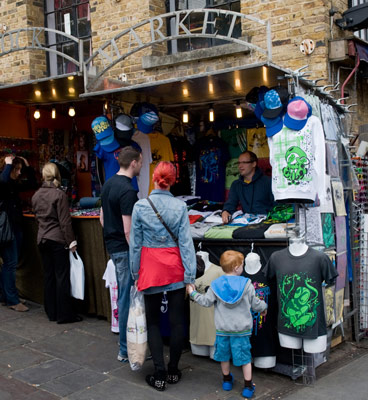
Exploring the bustling Camden Lock crafts market
For a first-time visitor, plunging into Camden’s maelstrom of markets can feel a little like tumbling down Alice in Wonderland’s rabbit hole. It is a passport to an incense-scented alternative universe where the tattooed and pierced buy and sell jewellery, clothes, music, novelties, furniture and food from right across London’s vivid cultural spectrum. Take a deep breath, hold on tight to little hands, and go with the flow.
The gentlest introduction is Camden Lock, a cute courtyard right beside Regent’s Canal, where prettily painted narrowboats chug out to Little Venice past ZSL London Zoo. The market hall next door majors in sparkly crafts and accessories, from earrings and scarves to candles and carvings, and there’s a tasty parade of multi-ethnic food stands. Behind here, things get more chaotic: the labyrinthine Stables Market occupies the site of the stables, horse hospital, warehouses and vaults connected with the canal trade in Victorian times – hence the bronze carthorses that spring out from assorted corners. Teenagers love the groovy goth-punk vibe, while the characterful Horse Tunnel area has more grown-up bric-à-brac.
Just across Chalk Farm Road is Camden Lock Village, another zone of mostly street-fashion stalls set in wooden cabins – look out for the food stands with mopeds as seating.
Kids’ Corner
Crazy Camden
The road from Camden Town tube to Camden Market must have the best shop-fronts in London. See if you can tick off these strange sights:
- A fierce dragon
- A Union Jack boot
- A giant scorpion
- A climbing cat
- A nose-diving plane.
Giddy-up!
In Victorian times, hundreds of horses were stabled in the Camden Market area. They pulled cargo between the canal, the railway and the roads, and Camden goods yard was the biggest in the world. How many horses can you spot? Score a point for every one you see and five points if you find a farrier – he’s a man who fits horseshoes.
4. Jewish Museum
A poignant 1,000-year immigrant odyssey
From the life of the Victorian prime minister Benjamin Disraeli to that of Auschwitz survivor Leon Greenman, the Jewish Museum puts an emphasis on personal stories. You can get a free taste of the museum from the ground-floor gallery, but the history hall is the highlight, tracing the 1,000-year story of Britain’s Jewish community, from their arrival with William the Conqueror in 1066. The senses are engaged: smell the chicken soup in a re-created East End street, play a board game based on the Jewish diaspora or try Yiddish karaoke. Especially poignant for kids are the keepsakes from the Kindertransport, carried by the 10,000 Jewish children who fled Nazi Germany in 1939.
5. Madame Tussauds
Schmooze with the stars
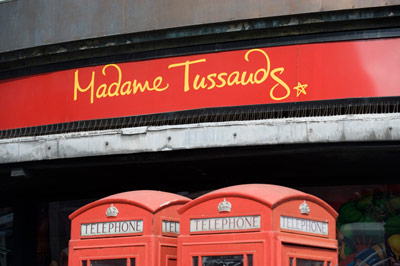
Iconic red telephone boxes outside the world-famous Madame Tussauds
No attraction in the capital divides opinion quite like Marie Tussaud’s 175-year-old waxwork show. Despite the pricey admission, visitors queue around the block – and that’s really the problem. The galleries can get crowded, defeating the main purpose of a visit – to have your photograph taken with Lady Gaga, Rihanna or Johnny Depp. Small children may even struggle to see their heroes in the melee. But go when it’s quieter, ideally on a weekday morning, and there’s no denying the glamour of walking into the first hall – a celebrity party where the likes of Kate Winslet, Robert Pattinson and Emma Watson are waiting for their close-up. Most of the models are spookily lifelike, and there are no ropes to segregate visitors from “VIPs”, so you really can rub shoulders with the stars. Younger children may prefer the Hollywood hall, with its rampaging dinosaur and giant Shrek, while downstairs they can play simulated tennis and football (queues permitting), as Nadal and Beckham look on.
In the basement, the Scream horror attraction has live serial killers jumping out of shadowy corners – not for the under-13s. Younger kids can head straight for the two attractions at the end; a ride through London’s history in a black cab and a 4D film in which Spider Man, the Hulk and Wolverine battle baddies in modern London.
Kids’ Corner
Dummy run
How long does it take to make a Madame Tussauds model? Start adding up the numbers below to find the answer…
| Sculpt figure: |
350 hours |
| Make mould: |
175 hours |
| Insert hair: |
140 hours |
| Make eyes: |
14 hours |
| Make teeth: |
28 hours |
| Colour head: |
49 hours |
| Add costume: |
35 hours |
| Total time = |
|
Madame Tussaud’s facts
- Locked up during the French Revolution, she had her hair cut to prepare her for the guillotine!
- She was freed, but forced to make wax models of her friends’ chopped-off heads
- The guillotine used by the revolutionaries is on show in Tussauds’ Chamber of Horrors
6. Sherlock Holmes Museum
Home of the world’s most famous detective
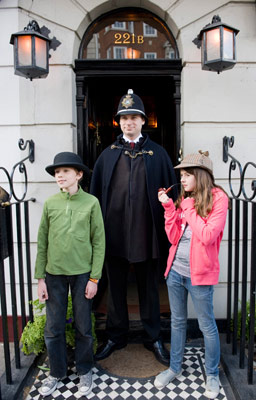
Youngsters in period hats, outside the front door of 221b Baker Street
It’s hard to think of many museums devoted to fictional characters – and indeed, some fans refuse to believe that Sir Arthur Conan Doyle’s great detective didn’t exist. There is a file of genuine letters here, from people around the world, asking for Sherlock Holmes’s help with solving their own personal mysteries.
Holmes the sleuth, repeatedly revived by Hollywood, lives on in this moody Victorian townhouse, though kids unfamiliar with the tales will feel a little clueless. The first mystery is the address: why is 221b Baker Street between numbers 237 and 241? Inside, staircases creak, gas-lamps splutter and Dr Watson lurks on the landing, ushering visitors into Holmes’s study to sit in his chair, or even puff on his pipe. The other five rooms are filled with clues and murder weapons from his famous cases. It is atmospheric, if rather kitschy, and there’s not much on more recent screen adaptations. One puzzle remains: why isn’t the cleaner dressed up as Mrs Hudson?
Kids’ Corner
Trick an adult
To make a grown-up look silly, ask them what kind of hat Sherlock Holmes wore? Did they say a deerstalker? Wrong! In the stories, Holmes wore a silk top hat.
7. The Wallace Collection
No Gromit, but lots of armour and The Laughing Cavalier
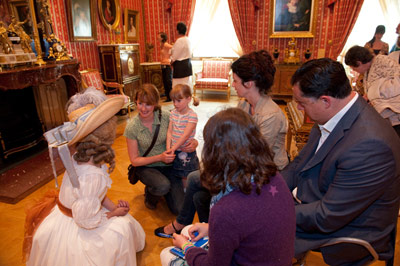
A “Meet Marie Antoinette” costumed talk at the Wallace Collection
First impressions can be deceptive. The Wallace Collection looks like a typical hushed and highbrow museum of old, a marbled mansion dripping with weighty chandeliers and gilt-framed Old Masters. Even its splendid restaurant has bibbed waiters and pricey food.
However, the Wallace is very keen to woo families: it has teamed up with pupils from a nearby school to create a children’s “acoustiguide” and I-Spy trails, and has published a kids’ art book based on key exhibits, for sale in the shop.
The collection was mostly put together by the Francophile Fourth Marquess of Hertford in the 1800s and is especially strong on French furniture and Sèvres porcelain – look out for Catherine the Great’s tea set. Children will be most excited by the rooms full of gleaming armour displays, which include Rajput warrior regalia and medieval knights on horseback. Upstairs, a series of stuccoed salons are lined with fine art, including Titians, Rembrandts, 22 Canalettos and a certain very famous jovial horseman.
Kids’ Corner
Ouch!
Tobias Capwell, keeper of the armour at the Wallace Collection, is a champion jouster. How many times do you think he’s been knocked off his horse in 16 years of jousting? The audio guide will help.
